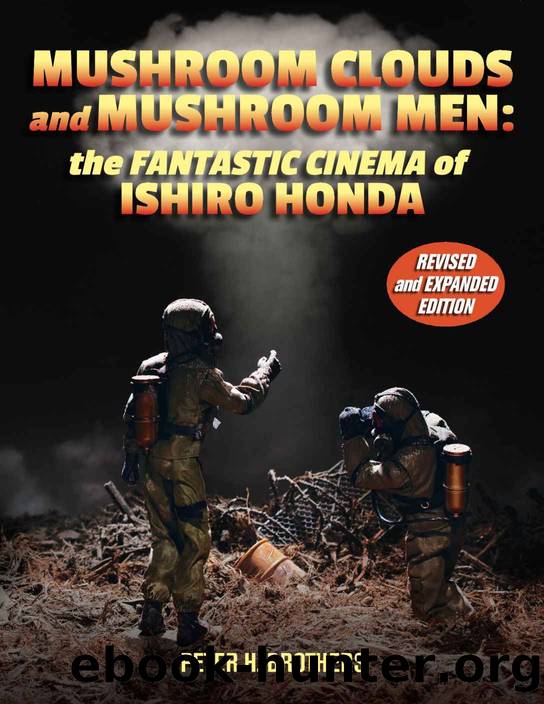Mushroom Clouds and Mushroom Men: The Fantastic Cinema of Ishiro Honda by Peter H. Brothers

Author:Peter H. Brothers [Brothers, Peter H.]
Language: eng
Format: epub
Publisher: CreateSpace
Published: 2013-11-10T05:00:00+00:00
Fourteen
MATANGO (1963)
ATTACK OF THE MUSHROOM PEOPLE âIt was a dark, starless night. We were becalmed in the Northern Pacific. Our exact position I do not know; for the sun had been hidden during the course of a weary, breathless week, by a thick haze which had seemed to float above us, about the height of our mastheads, at whiles descending and shrouding the surrounding sea . . .â
-- Opening paragraph from âThe Voice in the Nightâ by William Hope Hodgson. It has always been to Tomoyuki Tanakaâs enormous credit that he was willing to let his favorite monster movie director have the occasional experiment.
monster films were
As long as Hondaâs commercial successes, Tanaka could allow him the opportunity to direct something not necessarily guaranteed to reach a mainstream audience, and no one appreciated this more than the director himself who once said of Sekizawa and Kimuraâs screenplays: âThe actorsâ delivery were different for each of those two writersâ screenplays, which was very interestingâ (this was typical modesty as he surely had something to do with it as well). Great drama is always about things happening on different levels, and although people are always interested in conflicts between characters in a film, the most interesting conflicts are those within people, and while everyone has a personality they present to the world, in many cases it is not at all representative of whom they really are as individuals. Kurt Vonnegut once wrote that âWe are what we pretend to be, so we must be careful about what we pretend to be,â and Matango exhibits the seemingly pleasant dispositions of the various characters only to strip them away revealing something not quite so pleasant underneath.
The imaginative release poster for Matango. Matango was inspired by Hodgsonâs short story âThe Voice in the
Nightâ which was first published in The Blue Magazine in 1907. The story
concerns a yacht called the Albatross (Ahodori in Japanese) which comes
upon an unseen man in the mist pleading for food for himself and for his
female companion who are both marooned on an island. The man begs
not to be seen, and after receiving some food, tells his incredible tale of
woeful horror.
A number of key elements of Hodgsonâs story were put into the movie
in collaboration between science-fiction editor/writer Masami Fukushima
and Shinichi Hoshi. Takeshi Kimura drafted the final screenplay, and this
time his characters would be little more than animals both literally as well
as figuratively, reduced to lapping-up water, sucking eggs and licking roots.
Kimura relished every opportunity to bring down those in authority and was not above ridiculing his own profession. During the storm scene on the yacht when author Yoshida yells to psychology professor Murai:
âTo get a girl you scare them first then treat them tenderly. Am I right?â âThatâs not psychology,â Murai replies, âthatâs a paperback novel!â
Kimuraâs personal testaments about people ring throughout the film such as when Sakuta informs Koyama that âPeople act like children, regardless of how old they are. Thatâs just how the world is.â
For Kimura, whose beliefs in human values
Download
This site does not store any files on its server. We only index and link to content provided by other sites. Please contact the content providers to delete copyright contents if any and email us, we'll remove relevant links or contents immediately.
Kathy Andrews Collection by Kathy Andrews(11680)
The remains of the day by Kazuo Ishiguro(8748)
Paper Towns by Green John(5024)
Spare by Prince Harry The Duke of Sussex(4997)
The Body: A Guide for Occupants by Bill Bryson(4887)
Industrial Automation from Scratch: A hands-on guide to using sensors, actuators, PLCs, HMIs, and SCADA to automate industrial processes by Olushola Akande(4846)
Machine Learning at Scale with H2O by Gregory Keys | David Whiting(3973)
Be in a Treehouse by Pete Nelson(3876)
Harry Potter and the Goblet Of Fire by J.K. Rowling(3739)
Never by Ken Follett(3706)
Goodbye Paradise(3666)
Into Thin Air by Jon Krakauer(3261)
The Remains of the Day by Kazuo Ishiguro(3254)
The Cellar by Natasha Preston(3220)
The Genius of Japanese Carpentry by Azby Brown(3192)
Fairy Tale by Stephen King(3157)
120 Days of Sodom by Marquis de Sade(3118)
Drawing Shortcuts: Developing Quick Drawing Skills Using Today's Technology by Leggitt Jim(2960)
The Man Who Died Twice by Richard Osman(2957)
